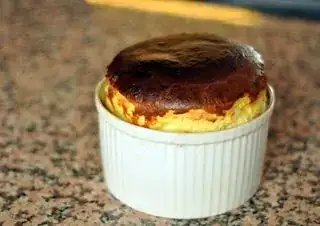I know that if a crust forms on top of a souffle or cake, it will lose its ability to rise (not flexible anymore).
I think that you got this part wrong.
A cake or souffle indeed stops rising when the proteins in them set, so the batter is not flexible any more. But it happens when the batter is set in the area which is supposed to rise. Recipes and baking instructions for cakes are designed so that crust formation on top and the setting inside happen at the same time, because then you have a nice, even cake.
If you have ever baked a cake shaped like a small hill, you will know what happens when this fails. The upper crust of the cake is set and cannot expand. The sides of the cake are already inflexible or semi-flexible and do not rise (much). The center is still completely flexible and continues rising, creating an unsightly buckle and cracking the upper crust.
But a souffle rises differently from a cake. There, you want to have a vertical rise only. This is why you use a ramekin. A ramekin is straight-sided, and it has thick, insulating ceramic walls and a smaller diameter than a cake pan. This ensures that during a normal baking process, your souffle won't get a liquid center and set walls in a horizontal cross-section. The vertical walls covered with generous amounts of butter plus a non-pasting granulate (frequently grated parmesan for cheese souffles, nut flours for nut soufles, sometimes breadcrumbs) as opposed to flour for cakes, give you perfect vertical expansion while not permitting sideways expansion.
As SAJ14SAJ mentioned, a grill/broiler heats in a very specific way. It heats surface very quickly to very hot temperatures, but the heat does not really penetrate well under the crust. (It does so, but very slowly. This is why grilled chicken has to be rotated all the time, else its skin would burn hopelessly by the time the inside is cooked). By placing the souffle under the grill, you cook the crust only, to a very small depth. The crust itself cannot rise anymore, but this is not tragic, as the depth of the crust will be very small in comparison to the complete height of risable batter. The batter below it will not set. It will not even become semi-flexible. It will remain raw and perfectly risable. When you then put the souffle into a normal oven with bottom heat, the raw batter will be able to rise normally. It will just push the hard crust upwards.
So, the theory says that the trick can work well. I have not tried it myself and cannot say whether it has a noticeable effect. This will depend on how much steam is lost through the raw batter surface when the souffle is baked normally.
I hope that this clears up the question about why it can function for rising. The ideas provided in other answers, such as the tasty crust, are a further reason to try the technique.
